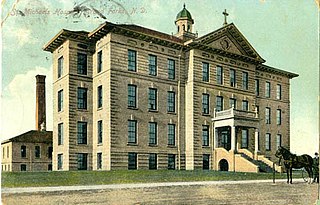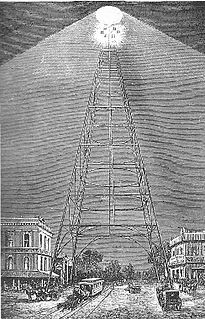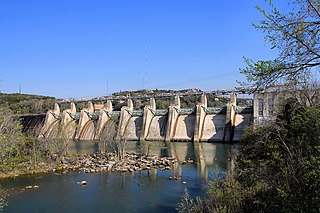
The Brazos River, called the Río de los Brazos de Dios by early Spanish explorers, is the 11th-longest river in the United States at 1,280 miles (2,060 km) from its headwater source at the head of Blackwater Draw, Curry County, New Mexico to its mouth at the Gulf of Mexico with a 45,000-square-mile (116,000 km2) drainage basin. Being one of Texas' largest rivers, it is sometimes used to mark the boundary between East Texas and West Texas.

Dazed and Confused is a 1993 American coming-of-age comedy film written and directed by Richard Linklater. The film features a large ensemble cast of actors who would later become stars, including Jason London, Ben Affleck, Milla Jovovich, Cole Hauser, Parker Posey, Adam Goldberg, Joey Lauren Adams, Matthew McConaughey, Nicky Katt, and Rory Cochrane. The plot follows various groups of Texas teenagers during the last day of school in 1976.

Barton Springs Pool is a recreational outdoor swimming pool that is filled entirely with water from nearby natural springs. It is located on the grounds of Zilker Park in Austin, Texas. The pool exists within the channel of Barton Creek and utilizes water from Main Barton Spring, the fourth largest spring in Texas. The pool is a popular venue for year-round swimming, as its temperature hovers between about 68 °F (20 °C) and 74 °F (23 °C) year round.

Zilker is a neighborhood in south central Austin, Texas. It extends south of Lady Bird Lake, approximately bounded by the Union Pacific Railway to the southeast/south, Barton Skyway to the south, Rabb Road and Robert E Lee Road to the west and Lady Bird Lake to the north.

South Portland is a long, narrow neighborhood just south of Downtown Portland, Oregon, hemmed in between the Willamette River and the West Hills. It stretches from I-405 and the Marquam Bridge on the north, to SW Canby St. and the Sellwood Bridge in the south. The Willamette forms the eastern boundary, and SW Barbur Blvd. most of the western boundary. In addition to Downtown to the north, other bordering neighborhoods are Southwest Hills, Homestead, Hillsdale, and South Burlingame to the west, and Hosford-Abernethy, Brooklyn, and Sellwood-Moreland across the river on the east.

Saint Mary's Cathedral is the cathedral parish of the Catholic Diocese of Austin located in Austin, Texas, United States. It was listed on the National Register of Historic Places in 1973, as St. Mary's Cathedral.

The recorded history of Austin, Texas, began in the 1830s when Anglo-American settlers arrived in Central Texas. In 1837 settlers founded the village of Waterloo on the banks of the Colorado River, the first permanent settlement in the area. By 1839, Waterloo would adopt the name Austin and become the capital of the Republic of Texas.

Downtown Austin is the central business district of Austin, Texas. Downtown is located on the north bank of the Colorado River. The approximate borders of Downtown include Lamar Boulevard to the west, Martin Luther King, Jr. Boulevard and the University of Texas at Austin to the north, Interstate 35 to the east, and Lady Bird Lake to the south.

The Arts & Entertainment District, or previously known as Omni, is a neighborhood of greater Downtown, Miami, Florida, United States, just south of Edgewater. It is bound roughly by North 19th Street to the north, North 10th Street to the south, North East 2nd Avenue to the west, and Biscayne Boulevard to the east.
Allandale, Austin, Texas is a neighborhood in North Central Austin, in the U.S. State of Texas.The neighborhood is known for its large lots, mature trees and central location.

George Hancock was an architect active in North Dakota, Montana and Minnesota. He moved to the area in 1882, settling in Fargo, North Dakota with his brother Walter when they were 33 and 17, respectively. After a fire destroyed much of Downtown Fargo in 1893, George and Walter designed around half of the replacement buildings. After advocating for a 1917 law requiring architects in North Dakota to be licensed, he and Walter became the first two licensed architects in the state.

The Missouri Valley Bridge & Iron Co., also known as Missouri Valley Bridge Company, was a firm that built many bridges. It was based in Leavenworth, Kansas, with a WWII facility in Evansville, Indiana.
The Bend Park & Recreation District is the agency which protects the parks, natural areas, recreational facilities, gardens, and trails of the city of Bend, Oregon.

Clayton is a neighborhood located in the city and county Denver, Colorado. Often confused with Park Hill, Cole, or the City Park neighborhoods, Clayton is a distinct neighborhood as defined by the city of Denver. The neighborhood is named for the historical former George W. Clayton Trust and College located on the northwest corner of Martin Luther King Blvd. and Colorado Blvd. This college has been listed on the National Register of Historic Places.

The Capitol View Corridors are a series of legal restrictions on construction in Austin, Texas aimed at preserving the visibility of the Texas State Capitol from various points around the city. First established by the Texas Legislature in 1983 and recodified in 2001, the corridors are meant to protect the capitol dome from obstruction by high-rise buildings. The corridors significantly limit the potential for the development of new tall structures in downtown Austin.
The Green Line is a proposed light rail transit (LRT) line in Calgary, Alberta, Canada. When built, it will be the third line in the CTrain network which will be known as Route 203, after the Red Line and the Blue Line, as well as the first line to operate low-floor trains.






















